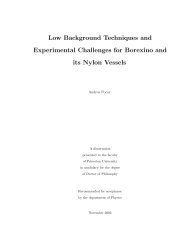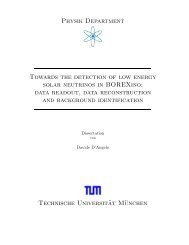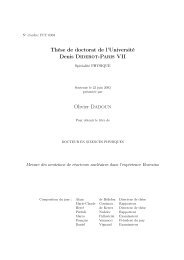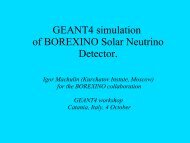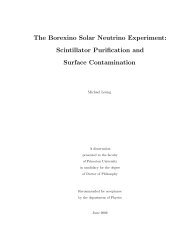Development of a Liquid Scintillator and of Data ... - Borexino - Infn
Development of a Liquid Scintillator and of Data ... - Borexino - Infn
Development of a Liquid Scintillator and of Data ... - Borexino - Infn
You also want an ePaper? Increase the reach of your titles
YUMPU automatically turns print PDFs into web optimized ePapers that Google loves.
1 Solar Neutrinos<br />
1.2.3 Future Experiments<br />
<strong>Borexino</strong> <strong>and</strong> KamLAND<br />
BOREXINO <strong>and</strong> KamLAND [Bra00, Pie01] both aim to detect solar Be neutrinos by neutrinoelectron<br />
scattering using liquid scintillation spectroscopy. The physics goals <strong>and</strong> the design <strong>of</strong><br />
BOREXINO will be described in more detail in chap. 2. The design <strong>of</strong> KamLAND is very similar<br />
to that <strong>of</strong> BOREXINO, but with three times larger scintillator mass (1000 t). The KamLAND<br />
detector is currently under construction in the old Kamioka site (Japan); data taking will start<br />
in 2001. The first stage <strong>of</strong> KamLAND is primarily devoted to detecting reactor antineutrino<br />
oscillations. At a later time, low-energy solar neutrino detection is also envisioned, but this will<br />
require an additional improvement <strong>of</strong> radiopurity beyond the present design specifications.<br />
LENS<br />
The LENS project (l ¯ ow ēnergy n ¯ eutrino s ¯ pectrometer) aims for real-time spectroscopy <strong>of</strong> solar<br />
electron neutrinos in the sub-MeV energy range [Rag97, Cri00]. It will use scintillator loaded<br />
with Yb, Gd or In for the detection <strong>of</strong> the inverse beta decay<br />
ÄÙ <br />
Ì <br />
ÁÒ ËÒ <br />
Î<br />
Î<br />
Î<br />
Characteristic electron-gamma coincidence signatures due to isomeric states occupied in the<br />
daughter nuclei (with lifetimes <strong>of</strong> ns) could help to achieve the required background<br />
reduction at very low energies. Combining the measured CC-rate <strong>of</strong> Be neutrinos in LENS<br />
with the rate measured in BOREXINO (CC + NC) could give an unambiguous pro<strong>of</strong> <strong>of</strong> neutrino<br />
oscillations.<br />
8



